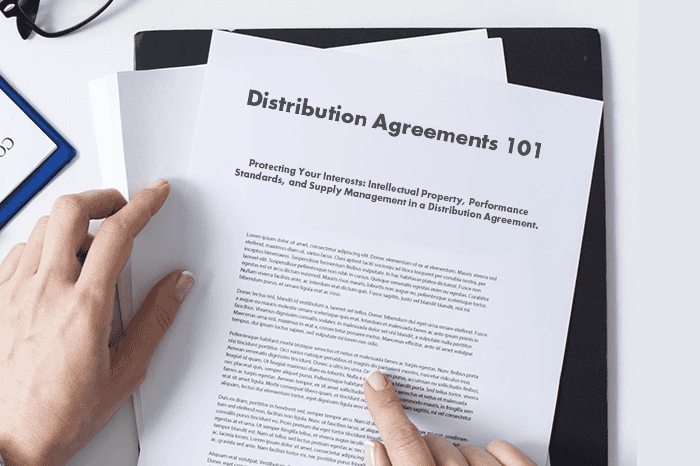
A distribution agreement is a binding contract between a company that provides its goods and service to another company for the purpose of sale. The company that purchases these goods from the producing company is known as a distributor, while the company that produces the products is known as the supplier. A distribution Agreement allows the supplying company to focus on producing and developing its products without allocating valuable resources for marketing and sale purposes.
With their countless advantages for either party, distribution agreements bear their own unique set of risks. A supplier might be risking or compromising its interests while entering a distribution agreement. In order to ensure that the interests of the supplier are protected, they can secure intellectual property rights over their products, monitor the adherence to performance standards, and regulate supply management.
Methods of protecting your interests in a Distribution Agreement
When a supplier enters a distribution agreement, it is crucial to ensure that any intellectual property rights over their products are not compromised during the purchase. Since the distributor assumes the responsibility of selling your products, they have ownership or possession over the goods and services of the supplying company. However, this exchange does not require the supplier to surrender their interests. They may use the following methods to protect it:
1) Protection of Intellectual Property Rights:
Depending on the goods and services produces by your company, you may have the right to preserve the monetary benefits you can have from the authenticity of your ideas. In order to do that you should identify your products as intellectual property and the company as its owner. Copyrights, trademarks, patents and other techniques are employed for the preservation of the intellectual right of the original creation. Recognize what means is best suitable for your product. After specifying the ownership, you may then license it to your distributors without the need to sell your intellectual property.
Protecting your company’s intellectual property could range from protecting its logo to its services. You will have to specify your ownership to the distributing company. To do so, you may include a clause concerning the protection of your intellectual property in the distribution agreement. Specifying your ownership in writing through the distribution agreement not only clarifies the ownership to the distributor but also assists your case in the situation of potential infringements. Including a provision concerning intellectual property rights in the distribution agreement prevents the distributor from claiming ignorance of fact in court.
Licensing your rights to the distributor for temporary usage can also be a great way of protecting your interests and your intellectual property rights over your services. The licensing is temporary and should be mentioned in the contract. While granting the distributor the right to use your intellectual property for purposes like marketing, specify its terms, its scope, and its limitations. Clarifying the limitations of the license prevents an unintentional misuse of your intellectual property rights.
2. Regulation of Performance Standards:
Ensure that you set out clear expectations from the distributor. When drafting the distribution agreement, the performance standard ranging between product advertisement, customer care, repairs, services, and relevant warranties should be carried out by the distributor. You can also set a sales target in the contract in order to ensure that your agreement reaches its goal. You can also oversee whether the marketing requirements for your services are being satisfied by the distributor. Observing the customer rating and feedback is an efficient method of understanding the status of your product among customers.
Extending liabilities is a coherent method to ascertain that the distributors are fulfilling their due diligence. This can be done by involving termination clauses that state poor performance as reasoning for contract termination. Additionally, you may also require the company to pay monetary compensation when they do not meet performance standards. These terms ought to be negotiated in the distribution agreement.
Finally, the supplier set up a process that allows them to monitor the performance of the distributor. You may require the distributing party to provide a monthly report on their performance. Regular monitoring of the warehouses or their distributing location can also provide insight into their methods. The suppliers may establish protocols by addressing performance issues.
3. Supply Management:
The supplier can play a more significant role in the management of supply in order to protect their interests. First, they need to clarify the type of products that the distributor is allowed to sell. The limitation includes the permission to sell a certain product in a specific region. This is known as the geographical limitation. The distributor does not hold the authority to sell products outside the location or area specified in the distributor’s agreement. The supplier may also levy restrictions on customer segments.
The second step to regulating the management of supply includes the establishment of price. You can determine the pricing structure for your product and these price structures can be adjusted over time. Adjusting the pricing structure helps the supplier and the distributor reflect the changes in market conditions and costs in their exchange.
Finally, you may set delivery terms in your favor in the distribution agreement. Delivery terms entail methods of shipping your product, timeframes for it, the number of orders the distributor may place at a time, the requirements for the handling and storage of the products, or other logistical details.
Conclusion
Intellectual property rights, performance standard observation, and the regulation of supply management are the key areas a supplier should focus on to ensure that their interests are protected and that they can continue a long-term relationship with their distributors. These methods add accountability to the actions of the distributor and increase the chances of the suppliers securing compensation in case of a legal conflict. While drafting a distribution agreement, working closely with business and legal advisors is vital. Both parties should reach a negotiation that can favor and foster a long-term relationship and exchange. When the interests of the supplier or the distributor are compromised significantly in the negotiation process, the chances of the contract being terminated without reaching its term are higher.






